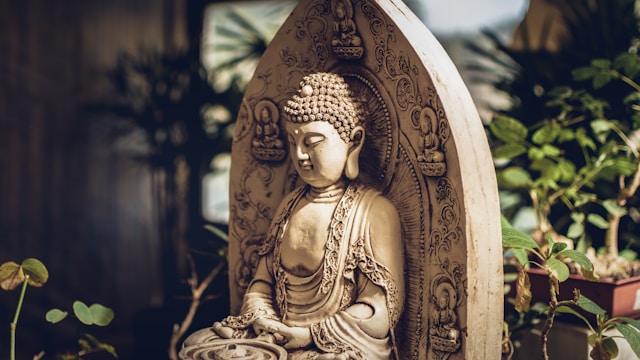Meditation is at the heart of Buddhist practice, offering a path to inner peace, clarity, and enlightenment. While many people associate meditation with relaxation, Buddhist meditation goes much deeper.
It is a systematic practice that develops mindfulness, concentration, and wisdom.
In this article, we will explore the three core Buddhist meditation techniques:
- Sati (Mindfulness) – The practice of present-moment awareness
- Samatha (Concentration) – The cultivation of mental calmness and stability
- Vipassana (Insight) – The development of wisdom through deep observation
Understanding these techniques will help you integrate meditation into your daily life, reduce stress, and cultivate a deeper awareness of reality.

1. Sati (Mindfulness) – The Art of Present-Moment Awareness
Sati, commonly translated as mindfulness, is the foundation of all Buddhist meditation. It means maintaining constant awareness of thoughts, emotions, and sensations without attachment or judgment.
Why is Sati Important?
✔️ Helps you recognize thoughts and emotions without being controlled by them
✔️ Reduces stress and anxiety by keeping you grounded in the present
✔️ Strengthens focus and clarity in daily life
How to Practice Sati
- Breath Awareness: Observe your breath as it flows naturally, without trying to control it.
- Body Scan Meditation: Bring awareness to different parts of the body and any sensations present.
- Thought Observation: Watch thoughts arise and pass away without engaging with them.
- Daily Mindfulness: Apply awareness to everyday activities like eating, walking, or working.
💡 Tip: The key to mindfulness is to observe without reacting. Simply notice what is happening in your mind and body, and let it be.
2. Samatha (Concentration) – Cultivating Inner Stillness
Samatha, or tranquility meditation, is the practice of developing deep focus and calmness. It is often achieved by concentrating on a single object, such as the breath, a mantra, or a visual image.
Benefits of Samatha Meditation
✔️ Increases mental stability and emotional resilience
✔️ Reduces distractions and enhances deep concentration
✔️ Prepares the mind for Vipassana (insight meditation)
How to Practice Samatha
- Choose a Focus Object – This could be your breath, a candle flame, a mantra, or even a simple sound.
- Eliminate Distractions – Find a quiet place where you won’t be interrupted.
- Bring Your Mind Back – Each time your mind wanders, gently return your focus to the object.
- Deepen the Practice – Over time, the mind becomes calmer, sharper, and more focused.
💡 Tip: Samatha is not about stopping thoughts but about training the mind to remain steady and undisturbed.
3. Vipassana (Insight) – Seeing Reality as It Is
Vipassana means “clear seeing” or “insight”. It is the practice of deeply observing reality, understanding the impermanent and interconnected nature of all things.
Why is Vipassana Important?
✔️ Develops profound wisdom and inner freedom
✔️ Helps dissolve mental suffering and attachments
✔️ Leads to direct insight into impermanence (anicca), suffering (dukkha), and non-self (anatta)
How to Practice Vipassana
- Observe Everything as It Is – Notice thoughts, emotions, and sensations without labeling them as good or bad.
- Recognize Impermanence – Understand that all experiences arise and pass away.
- Let Go of Attachment – See that clinging to thoughts and emotions creates suffering.
- Deep Awareness in Daily Life – Apply insight to everyday situations, recognizing that nothing is permanent.
💡 Tip: Vipassana is about direct experience rather than intellectual understanding. The more you observe, the deeper your wisdom grows.
How These Three Practices Work Together
Meditation Type Purpose Main Benefit
| Sati (Mindfulness) | Awareness of the present moment | Recognizing thoughts and emotions without attachment |
| Samatha (Concentration) | Mental calmness and stability | Strengthening focus and deep concentration |
| Vipassana (Insight) | Seeing the true nature of reality | Developing wisdom and inner freedom |
Rather than separate practices, these three techniques support and strengthen each other.
- Sati keeps you aware.
- Samatha provides the stability needed for deep insight.
- Vipassana leads to wisdom and liberation.
By integrating all three, you develop a balanced meditation practice that leads to lasting peace and clarity.
Start Your Meditation Journey Today
Buddhist meditation is not just about relaxation—it is a profound path to self-discovery and liberation.
Whether you begin with mindfulness (Sati), concentration (Samatha), or insight (Vipassana), each practice brings you closer to a clearer, more peaceful mind.
✨ Which meditation practice resonates with you the most? Share your thoughts in the comments below!



